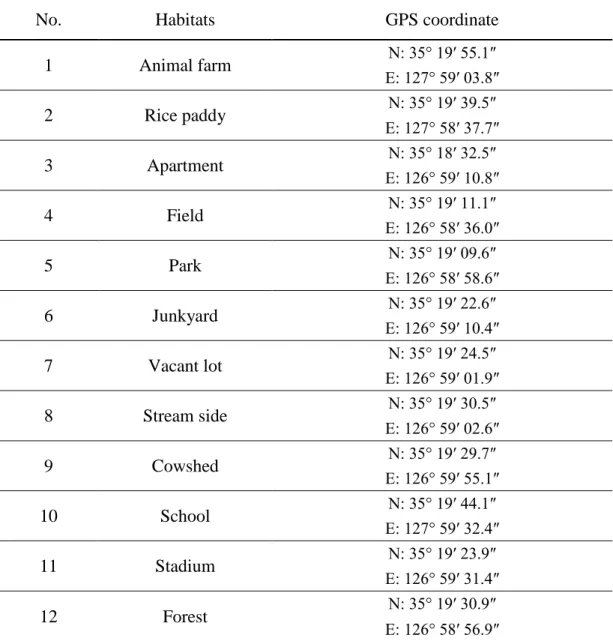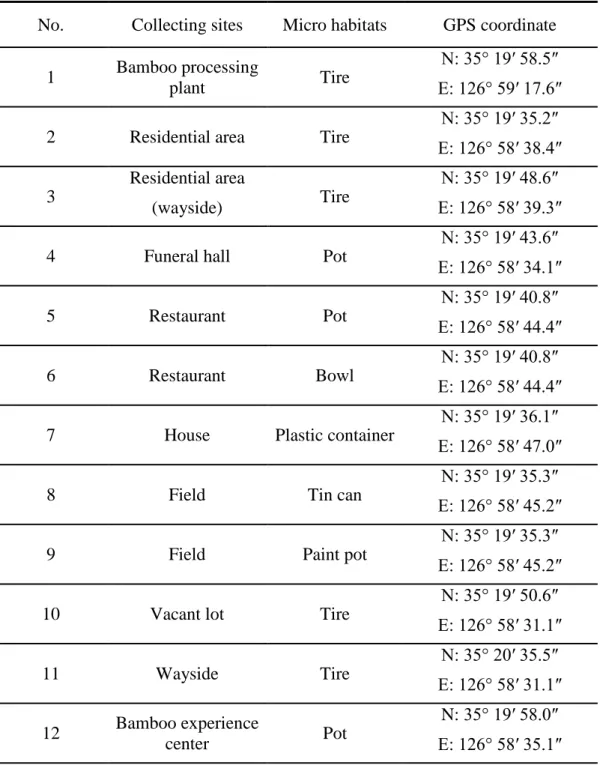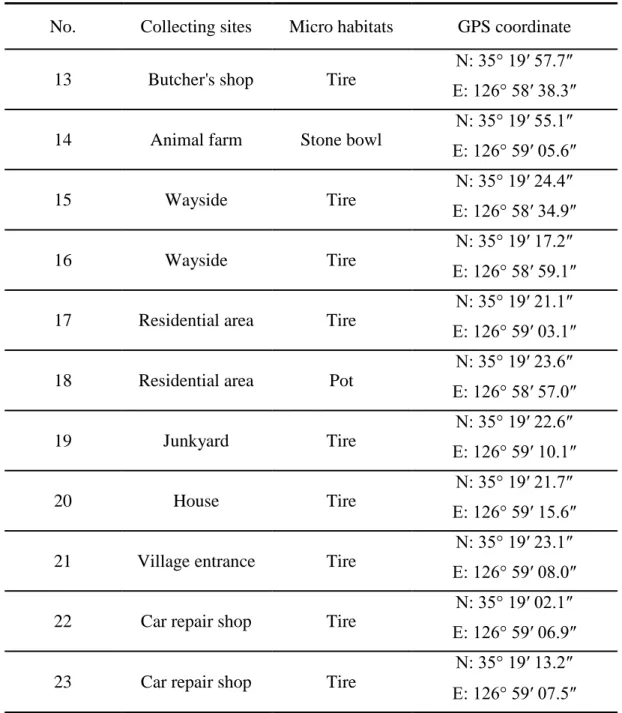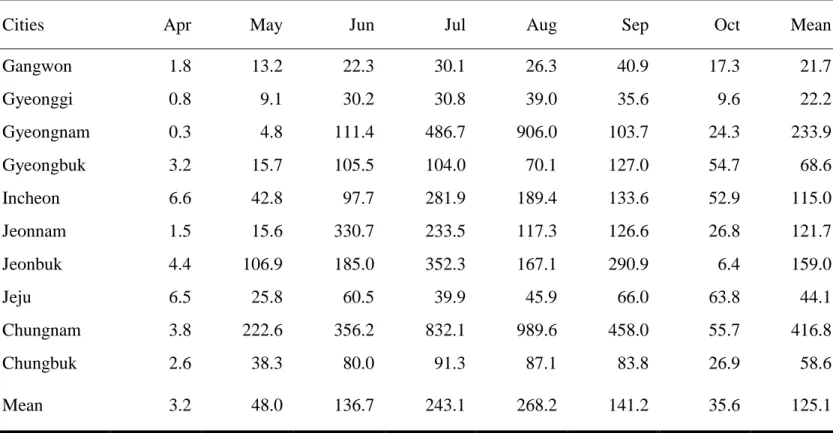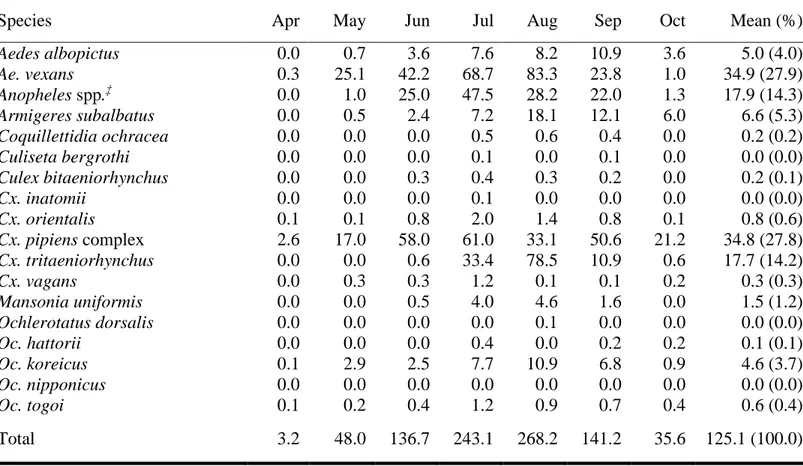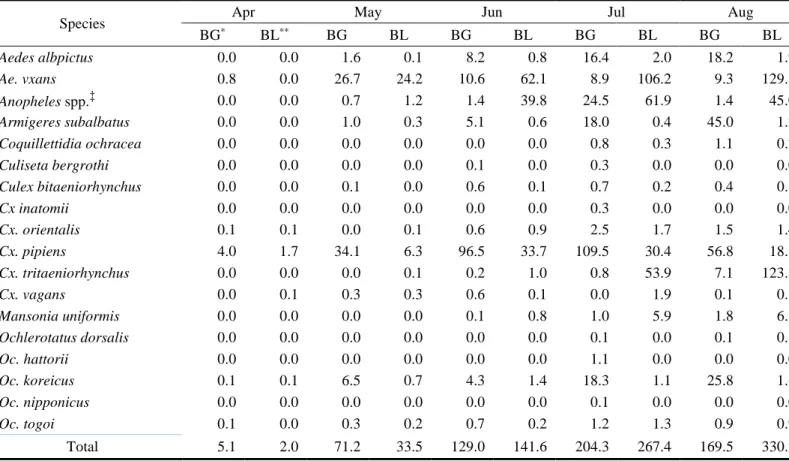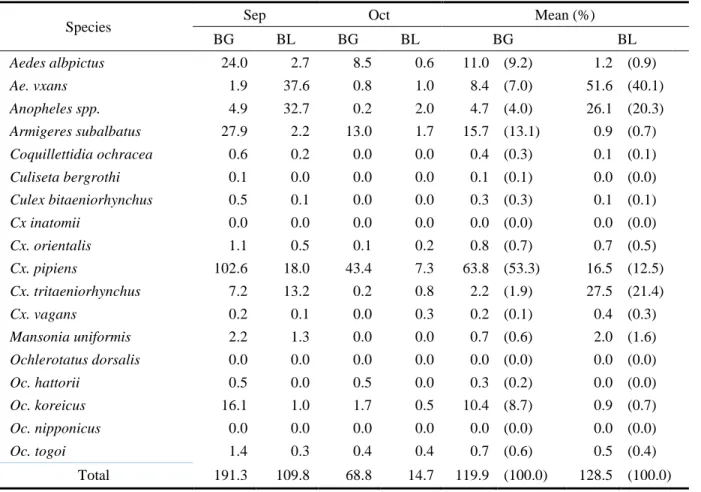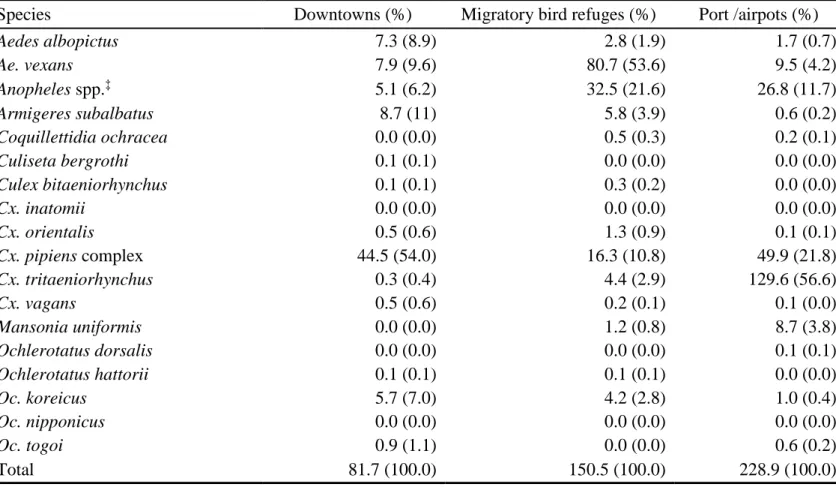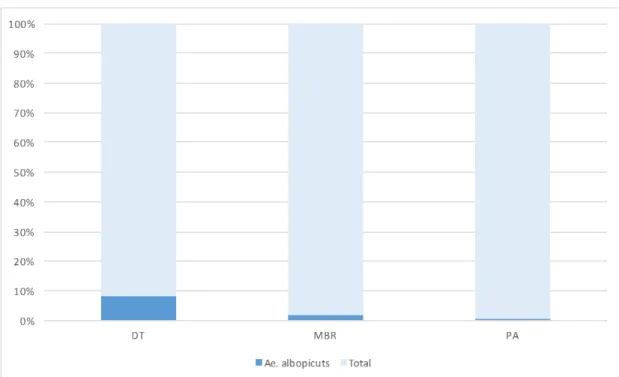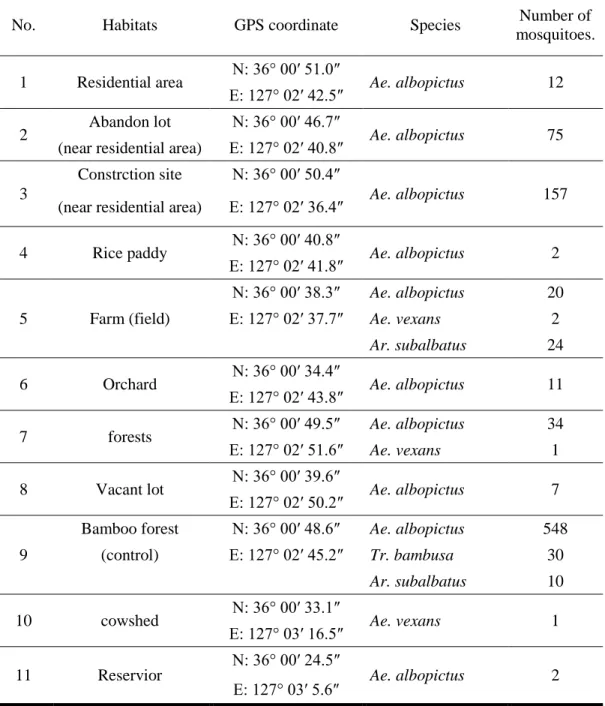저작자표시-비영리-변경금지 2.0 대한민국 이용자는 아래의 조건을 따르는 경우에 한하여 자유롭게 l 이 저작물을 복제, 배포, 전송, 전시, 공연 및 방송할 수 있습니다. 다음과 같은 조건을 따라야 합니다: l 귀하는, 이 저작물의 재이용이나 배포의 경우, 이 저작물에 적용된 이용허락조건 을 명확하게 나타내어야 합니다. l 저작권자로부터 별도의 허가를 받으면 이러한 조건들은 적용되지 않습니다. 저작권법에 따른 이용자의 권리는 위의 내용에 의하여 영향을 받지 않습니다. 이것은 이용허락규약(Legal Code)을 이해하기 쉽게 요약한 것입니다. Disclaimer 저작자표시. 귀하는 원저작자를 표시하여야 합니다. 비영리. 귀하는 이 저작물을 영리 목적으로 이용할 수 없습니다. 변경금지. 귀하는 이 저작물을 개작, 변형 또는 가공할 수 없습니다.
A THESIS
FOR THE DEGREE OF DOCTOR OF PHILOSOPHY
Distribution, abundance and blood-feeding behavior
of Aedes albopictus (Diptera: Culicidae) in Korea
국내 흰줄숲모기의 분포, 발생 및 흡혈행동 연구
By
Hyunwoo Kim
Department of Agricultural of Biotechnology
Seoul National University
Distribution, abundance and blood-feeding behavior of Aedes albopictus (Diptera: Culicidae) in Korea
국내 흰줄숲모기의 분포, 발생 및 흡혈행동 연구
UNDER THE DIRECTION OF ADVISER SI HYEOCK LEE SUBMITTED TO THE FACULTY OF THE GRADUATE SCHOOL
OF SEOUL NATIONAL UNIVERSITY
By Hyunwoo Kim
Major in Entomology
Department of Agricultural Biotechnology Seoul National University
February, 2017
APRROVED AS A QUALIFIED DISSERTATION OF HYUNWOO KIM FOR THE DEGREE OF DOCTOR OF PHILOSOPHY
BY THE COMMITTEE MEMBERS
CHAIRMAN Young-Joon Ahn
VICE CHAIRMAN Si Hyeock Lee
MEMBER Seunghwan Lee
MEMBER Wook-Gyo Lee
Distribution, abundance and blood-feeding behavior of Aedes
albopictus (Diptera: Culicidae) in Korea
Program in Entomology
Department of Agricultural Biotechnology, Seoul National University
Hyunwoo Kim
ABSTRACT
Aedes albopictus is an invasive mosquito that can be found in all continents. This
species, considered as a secondary vector of Dengue virus, has recently been suggested to play a role in the transmission of Zika virus in several countries bordering Brazil. This mosquito originated in the forests of Southeast Asia. However, this species has spread throughout the world by increased intercontinental trade during the 20th century.
In this study, I surveyed the distribution, abundance and main micro habitats of
followed by rapid decrease in number during October. The larval habitats were found within 500 m distance from the bamboo forest. Most larvae were found mainly in tires (44.4% in Iksan-si, 63.6% in Damyang-gun) and artificial containers (55.6% in Iksan-si, 45.5% in Damyang-gun) including a plastic wash basin, bowl, can, styrofoam-box within the range of adult mosquito activity.
Ae. albopictus activity began around sunrise with peaks in late morning (08:00–
09:00) and early evening (16:00–19:00) and ended with sunset. Light intensity appears to be a major factor affecting mosquito activity: if light intensity is over some threshold, Ae. albopictus activity decreased.
The main bloodmeal source of Ae. albopictus was mammals (71%) followed by birds (26%), amphibians (2%) and fish (1%). The main mammalian blood source was human (86%). This results showed that Ae. albopictus feed exclusively on human, representing the potential of this mosquito as a major vector of dengue virus, once this virus becomes domestic.
In flavivirus detection, no virus was detected in the specimens of Ae. albopictus, but a total of six Japanese encephalitis virus (JEV)-positive pools were detected from
Culex orientalis and Cx. pipiens except Cx tritaeniorhynchus, the main vector
mosquitos of JEV. All the detected JEVs were identified as genotype V by phylogenetic analysis of the envelope gene. Our findings confirmed that a new
genotype of JEV was introduced into Korea and suggested that the two mosquito species may play a role in JEV transmission.
To investigate the possibility of using Wolbachia, as one of biological control strategy, I investigated the distribution of Wolbachia infection in Ae. albopictus according to geographical distribution in Korea. Over 99% of the collected mosquitoes harbored Wolbachia, and the sequence homologies of the WSP gene showed more than 98% similarity within the mosquito species. Ae. albopictus was found to be infected with two Wolbachia strains, wAlbA and wAlbB. Regional distribution analysis indicated that the wAlbA strain of Wolbachia showed more than 98% sequence similarity among Ae. albopictus collected from different regions. This study would support further functional and biocontrol-related studies of Wolbachia.
Additionally, I also investigated the mosquito species composition by employing the DNA barcoding method based on the mitochondrial cytochrome c oxidase subunit
I (mtCOI) gene sequence. To this end, mtCOI genes from individual mosquitoes of 25 species were sequenced, and their phylogenetic relationship was analyzed. Phylogenetic analysis showed that most mosquito species were clustered according to morphological characteristics, except for certain Anopheles species. DNA barcoding using mtCOI genes successfully identified mosquito species, and it can be used as an
Key words: Aedes albopictus,distribution, abundance, seasonal prevalence, habitats, breeding sites, diel activity, bloodmeal source, Japanese encephalitis virus (JEV),
Wolbachia, wAlbA, wAlbB
Contents
Abstract ··· I Contents ··· V List of Tables ··· X List of Figures ··· XIII
Introduction ··· 1
CHAPTER I. Abundance and distribution of Aedes albopictus ··· 6
I-1. Distribution and Abundance of Aedes albopictus in Korea ··· 7
Abstract ··· 7
1. Introduction ··· 9
2. Materials and method ··· 11
2.1. Seasonal prevalence of Ae. albopictus ··· 11
2.1.1. Mosquito collecting ··· 11
2.1.2. ArcGIS geographical analysis ··· 13
3. Results ··· 25
3.1. Seasonal prevalence of Ae. albopictus ··· 25
3.2. Survey of main breeding habitats of Ae. albopictus ··· 36
4. Discussion ··· 47
CHAPTER II. Blood-feeding behavior of Aedes albopictus: host searching activity, host preference, virus infection rate and Wolbachia infection rate ··· 49
II-1. Daily activity of Aedes albopicus for searching hosts ··· 50
Abstract ··· 50
1. Introduction ··· 51
2. Materials and Methods ··· 53
2.1. General Description of Study Site ··· 53
2.2. Mosquito collection ··· 55
3. Results ··· 56
3.1. Mosquito collecting ··· 56
3.2. Activity of Ae. albopictus ··· 56
3.3. The effect of light intensity on Ae. albopictus activity ··· 59
II-2. Host feeding patterns of Aedes albopictus in an urban park ··· 69
Abstract ··· 69
1. Introduction ··· 71
2. Materials and Methods ··· 73
2.1. Study sites ··· 73
2.2. Mosquito collection and identification ··· 73
2.3. Blood meal analysis ··· 74
2.4. Dengue virus detection ··· 75
3. Results ··· 76
3.1. Mosquito collection ··· 76
3.2. Bloodmeal source identification ··· 79
3.3. Dengue virus detection ··· 82
4. Discussion ··· 83
II-3 Detection of Japanese encephalitis virus (JEV) in Aedes albopictus collected from the high risk area ··· 86
Abstract ··· 86
2.2. Virus detection ··· 93
2.3. Nucleotide sequencing and phylogenetic analysis ··· 94
3. Results ··· 98
3.1. Mosquito collection ··· 98
3.2. Virus detection and phylogenetic analysis ··· 101
4. Discussion ··· 110
II-4. Wolbachia infection rate in Aedes albopictus collected from different geographical locations in Korea ··· 114
Abstract ··· 114
1. Introduction ··· 116
2. Materials and Methods ··· 119
2.1. Mosquito collection ··· 119
2.2. DNA extraction and Polymerase Chain Reaction (PCR) ··· 122
2.3. Nucleotide sequencing and phylogenetic analysis ··· 122
3. Results ··· 125
3.1. Survey of Wolbachia in Ae. albopictus using the WSP gene ··· 125
3.2. Classification of Wolbachia in Ae. albopictus according to geographical distribution ··· 127
Literatures Cited ··· 133
Appendix ··· 148
Abstract in Korean ··· 157
List of Tables
CHAPTER I
I-1. Distribution and Abundance of Aedes albopictus in Korea
Table 1. Site of BG Sentinel trap setup and their GPS coordinate in Iksan-si ··· ··· 15 Table 2. The sites of larva mosquito surveyed in Iksan-si ··· 17 Table 3. The sites of BG Sentinel trap placed and GPS coordinate in Damyang-gun. ··· 20 Table 4. Sites of larval mosquitoes collected and their GPS coordinate in Damyang-gun. ··· 23 Table 5. Monthly trap indices of collected mosquitoes according to collecting sites ··· 27 Table 6. Monthly trap indices of collected according to collected species ···· 28 Table 7. Monthly trap indices of collected mosquitoes according to the collecting traps ··· 31 Table 8. Trap indices of collected modquitoes at downtown, migratory bird refuge and port or airpot areas ··· 34 Table 9. The micro habitats of mosquitoes collected by BG Sentinel trap at Iksan-si ··· 37
Table 10. The micro habitats of Ae. albopictus larvae collected in Iksan-si
··· 38 Table 11. The micro habitats of mosquitoes collected by BG Sentinel trap in Damyang-gun ··· 42 Table 12. The micro habitats of Ae. albopictus larvae collected in Damyang-gun ··· 43
CHAPTER II
II-1. Daily activity of Aedes albopicus for searching hosts
Table 1. Total number of mosquitoes collected by species and sites ··· 58 Table 2. Temperature, relative humidity, and light intensity at the mosquito collection sites ··· 61
II-2. Host feeding patterns of Aedes albopictus in the urban park
Table 1. The number of collected mosquitoes at urban park in Seoul ··· 77 Table 2. The number of collected mosquitoes at bamboo forest in Damyang
··· 78 Table 3. Host feeding preference of mosquitoes collected in urban park in Seoul ··· 80
III-3 Detection of Japanese encephalitis virus (JEV) in Aedes albopictus collected from the high risk area
Table 1. Primers for amplification of the complete envelope gene of JEV genotype V ··· 96 Table 2. Details of the Japanese encephalitis viruses used in the phylogenetic analysis ··· 97 Table 3. Total number of mosquitoes collected at 5 cities in South Korea
··· 99 Table 4. Total number of female mosquitoes collected at mosquito collecting cities with four traps during May to October in 2012 ··· 100 Table 5. Results of flavivirus detection from field-caught mosquitoes ··· 104 Table 6. Japanese encephalitis viruses detected from mosquitoes in this study··· ··· 106 Table 7. Nucleotide sequence similarity and divergence of envelope gene among JEV genotype V ··· 109
II-4. Wolbachia infection rate in Aedes albopictus collected from different
Table 1. Wolbachia infection status according to mosquito sampling sites in Korea ··· 121
List of Figures
CHAPTER I
I-1. Distribution and Abundance of Aedes albopictus in Korea
Figure 1. Mosquito collecting and study sites. Red circles are indicating the mosquito collecting sites of seasonal prevalence of Aedes albopictus. Blue circles are the study sites of Ae. albopictus main breeding sites, having well-developed bamboo forests. ··· 12 Figure 2. Sites of BG-Sentinel trap setup in Icksan-si. The red dot indicates the site
of BG Sentinel trap setup. The number represents a habitat as this: 1. Residential area; 2. Abandon lot (near residential area); 3. Construction site; 4. Rice paddy; 5. Farm (field); 6. Orchard; 7. Forests; 8. Vacant lot; 9. Bamboo forest (control); 10. Cowshed; 11. Reservoir ··· 14 Figure 3. Sites of larval mosquitoe collection in Iksan-si. The red dot indicates the
site of BG Sentinel trap setup. The number represents a habitat as this: 1. Vacant lot, near house
(
tire); 2. Residential area, wayside (tire); 3. Residential area (tire); 4. Residential area (tire); 5. Residential area, an alley (plastic bowl); 6. Residential area, an alley (stone bowl); 7. Residential area (plastic bag); 8. Residential area, rest room (tin can); 9. Farm, vinyl green house(Styrofoam-Figure 4. Sites of BG-Sentinel trap placed in Damyang-gun. The red dot indicates the site of BG Sentinel trap setup. The number represents a habitat as this: 1. Animal farm; 2. Rice paddy; 3. Apartment; 4. Field; 5. Park; 6. Junkyard; 7. Vacant lot; 8. Stream side; 9. Cowshed; 10. School; 11. Stadium; 12. Forest. 19 Figure 5. Sites of larval mosquitoe collection in Damyang-gun. The red dot indicates
the site of BG Sentinel trap setup. The number represents a habitat as this: 1. Bamboo processing plant (tire); 2. Residential area (tire); 3. Residential area, wayside (tire); 4. Funeral hall (pot); 5. Restaurant (pot); 6. Restaurant (bowl); 7. House (plastic container); 8. Field (tin can); 9, Field (paint pot); 10. Vacant lot (tire); 11. Wayside (tire); 12. Bamboo experience center (pot); 13. Butcher's shop (tire); 14. Animal farm (stone bowl); 15. Wayside (tire); 16. Wayside (tire); 17. Residential area (tire); 18. Residential area (tire), 19. Junkyard (tire); 20. House (tire); 21. Village entrance (tire); 22. Car repair shop (tire); 23. Car repair shop (tire). ··· 22 Figure 6. Seasonal prevalence of Ae. albopcitus and other mosquitoes. Mosquitoes
were collected using Black light traps and BG Sentienl traps at 10 cities in Korea. Collecting numbers are represented by trap index (number of mosquito / nights x traps). ··· 29 Figure 7. The geographical distritution of Ae. albopcitus according to seasonal
Figure 8. The different collection rate of Ae. albopictus depending on mosquito habitats. Mosquitoes were collected by Black light traps and BG Sentienel traps. DT: Downtown area, MBR: migratory bird refuge, PA: Port or airport area. 33 Figure 9. The different collection rate of Ae. albopictus depending on the traps used
for mosquito collection. Mosquitoes were collected at three different habitats (downtown areas, migratory bird refuges and port and airport areas) in 10 sites in Korea. BG: BG Sentinel trap, BL: Black light trap. ··· 35 Figure 10. The micro habitats of Ae. albopictus larvae collected from Icksan-si. A:
Vacant lot (tire); B: Residential area (tire); C: Residential area (tire); D: Residential area (tire); E: Residential area (plastic bowl); F: Residential area (stone bowl); G: Residential area (plastic container); H: Residential area (plastic container); I Farm (Styrofoam-box). ··· 39 Figure 11. The distance of larvae collection site from the bamboo forest, the main
habitat of Ae. albopictus. The red dots indicate the micro habitats of Ae.
albopictus larvae collected. The yellow circles represent 100 m distance from
the bamboo forest, the main habitat of Ae. albopictus. ··· 40 Figure 12. The micro habitats of Ae. albopictus larvae collected from Damyang-gun.
A: Bamboo processing lot (tire); B: Residential area (tire); C: Residential area, wayside (tire); D: Funeral hall (pot); E: Restaurant (pots); F: Restaurant (bowl);
(tire); N: Animal farm (stone bowl); O: Wayside (tire); P: Wayside (tire); Q: Residential area (tire); R: Residential area (pot); S: Junkyard (tire); T: House (tire); U: Village entrance (tire); V: Car repair shop (tire); W: Car repair shop (tire). ··· 45 Figure 13. The distance of larvae collection site from the bamboo forest, the main
habitat of Ae. albopictus. The red dots indicate the micro habitats of Ae.
albopictus larvae collected. The yellow circles represent 100 m distance from
the bamboo forest, the main habitat of Ae. albopictus. ··· 46
CHAPTER II
II-1. Daily activity of Aedes albopicus for searching hosts
Figure 1. Location of this study, Damyang-gun, Korea. A) Site A, bamboo forest edge; B) Site B, 10 m into the forest; C) Site C, 15 m into the forest. ··· 54 Figure 2. Number of collected mosquitoes by time. Site A shows bimodality, with
two peaks in mosquito activity. The minor peak (white arrow) is at around 09:00, followed by the major peak (dark arrow) at around 17:00-18:00. Site C, where most mosquitoes were collected overall, has one broad peak. Activity at Site B was intermediate to that at Sites A and C. ··· 57 Figure 3. The effect of light intensity on the number of Aedes albopictus mosquitoes
Figure 4. Estimating a hypothetical threshold of light intensity for Aedes albopictus at Site A. Arrow line representing the hypothetical threshold. Both the major (at 17:00) and minor activity peaks (at 09:00) are under the threshold.
··· 63 Figure 5. The effect of temperature on Aedes albopictus activity. The 6.3°C
difference in temperature may cause the difference between mosquito activity at the two peaks (white arrow indicate the minor peak; dark arrow is major peak). ··· 65
II-2. Host feeding patterns of Aedes albopictus in the urban park
II-3 Detection of Japanese encephalitis virus (JEV) in Aedes albopictus collected from the high risk area
Figure 1. Locations of mosquito collection in South Korea. Mosquitoes were caught in five cities (four sites per city) once a month from May through October 2012. ··· 92 Figure 2. Results of real-time PCR amplification of Japanese encephalitis viruses
from field collected mosquitoes. K12HC959 is indicating the Cx. orientalis collected at Hwacheon; K12AS1148 is Cx. pipiens at Ansan; K12AS1151 is Cx.
orientalis at Yeoju; K12YJ1203 is Cx. orientalis at Yeoju. P is indicating
positive control and N is negative control. ··· 105 Figure 3. Phylogenetic analysis of Japanese encephalitis virus (JEV) based on the
complete envelope gene (1,500 nt) from 42 strains representing each genotypes and countries. The Maximum-Likelihood tree was constructed with a substitution model of Tamura-Nei plus gamma distribution using MEGA software 6.06. West Nile virus (WNV, B956 strain, NC_001563) was used as the outgroup in the tree. Branch reliability is indicated by the percentage of bootstrap values at each node (1,000 replications). The scale bar indicates the number of base substitutions per site. JEVs detected in this study were marked with a closed circle. The left side of the tree is omitted for ease of understanding. In a small rectangle, the topology of genotype V sequences in the original tree is presented. The branch length between K12AS 1154 and its ancestral node is zero and is edited to make the ancestor-descendant relationship clear. ··· 107
II-4. Wolbachia infection rate in Aedes albopictus collected from different
Figure 1. Mosquito collecting sites. Used map is for indicating the mountain chains and waterways. ··· 120 Figure 2. Phylogenic tree constructed based on partial WSP gene sequences.
Wolbachia of Aedes albopictus (GenBank accession no.: KF725080), Drosophila melanogaster (GenBank accession no.: AY888034, AF020063,
DQ412100), and Culex pipiens (GenBank accession no.: AF301010) were used as reference Wolbachia sequence. KOR-1, KOR-2, and KOR-3 were detected from Ae. albopictus in Korea. Bactericera cockerelli (GenBank accession no.: AY971948) was selected as an out-group. ··· 126 Figure 3. Wobachia infeation rate in Ae. albopictus according to the geographical
regions. N is indicating the number of collected Ae. albopictus; wAlbA, wAlbB is Wolbachia strains found in Ae. albopictus ··· 128 Figure 4. Confirmation of Wolbachia strains according to geographical distribution.
According to PCR analysis, all samples were found to be infected with the wAlbA strain, but 98% of samples were found to be infected with the wAlbB strain, regardless of geographical distribution. ··· 129 Figure 5. Phylogenic tree constructed based on partial wAlbA. Sequence analysis and
phylogenic tree construction were conducted by DNASTAR software. DG (Daegu), BM (Bomok), GH (Goheung), GJ (Gyeongju), GN (Gangneung), US (Ulsan), SS (Seosan), JJ (Jeonju), CC (Chuncheon), DY (Damyang), and CA (Cheonan) indicate collection areas in South Korea. ··· 130
INTRODUCTION
The Asian tiger mosquito, Aedes albopictus, is characterized by black and white stripes on its legs and body as first described as “the banded mosquito of Bangla” by Skuse (1894) (Gratz, 2004). This species is also an invasive species that can be found in Asia, Europe, North America, South America, and Africa (Paupy et al., 2009). The spread of this species has occurred during recent thirty years by human activities (Lounibos, 2002). As an important vector of dengue fever (DENV), chikungunya (CHIKV), yellow fever, and also Zika in recent, Ae. albopictus has considered as a global public health threat (Rezza, 2012; Schuffenecker et al., 2006).
As Ae. albopictus is usually found at the edges of forests and breeds in natural habitats such as tree holes and bamboo stumps, it used to be considered as a rural mosquito (Higa, 2011). However, Ae. albopictus has adopted to urban environments with ecological plasticity. Ae. albopictus has exploited alternative blood sources such as human and domestic animals and adaped to use artificial container such as waste tires and plastic water containers as their breeding habitats (Caputo et al., 2012). This process of “domestication” has leaded Ae. albopictus to become a main mosquito species occuring in both rural and suburban areas (Paupy et al., 2009).
Ae. albopictus is also known as a daytime mosquito. Unlike other mosquitoes,
1995; Hawley, 1988). Depending upon region and biotype, they showed different active peak time, but for the most part, they rest during the night hours.
Ae. albopictus not only prefers to bite mammals including humans, but also
birds, reptiles, and amphibians (Hawley, 1988). Due to its opportunistic behavior, Ae.
albopictus was previously considered as having limited opportunity to acquire or
transmit arboviruses such as dengue virus (Richards et al., 2006). While the preferences of Ae. albopictus for animals versus humans were shown to be highly variable according to the geographic origin of mosquito population, when given the choice between human and animal bait, Ae. albopictus chose the human priory (Paupy et al., 2009). These traits of feeding behavior make Ae. albopictus particularly an efficient bridge vector that can transmit pathogens from animal-to-animal and from animal-to-human.
The ability of Ae. albopictus transmitting disease as a vector mosquito has been experimentally demonstrated for a wide range of arboviruses. Ae. albopictus have shown to be capable of transmitting 26 viruses that belong to the Flaviviridae (genus
Flavivirus), Togaviridae (genus Alphavirus), Bunyaviridae (genus Bunyavirus and Phlebovirus), Reoviridae (genus Orbivirus) and Nodaviridae (genus Picornavirus)
family. In addition, viral isolation or detection in the field conditions has been reported, including six flaviviruses (DENV-1, -2, -3, -4, West Nile virus, Japanese
and six bunyaviruses (Potosi virus, Tensaw virus, Keystone virus, La Crosse virus and Jamestown Canyon virus) (Paupy et al., 2009).
The primary vector of the DENV is known to be Ae. aegypti, which is present in most areas where the disease is endemic, whereas Ae. albopictus has been considered as a secondary vector, particularly in the areas where both species co-exist. However, the report of major epidemics in the areas where Ae. albopictus occurs alone demonstrates the potential role of Ae. albopoictus in DENV transmission and outbreaks (Kutsuna et al., 2015b).
Because there are no vaccines or drugs against DENV and CHIKV, vector control is considered as a principal method for the prevention and control of these disease. The control of Ae. albopictus has conventionally relied on the reduction of the larval source by cleaning the water-holding containers that serve as larval habitats and by using larvicides in breeding sites (Hawley, 1988). Recently, a novel form of biological control strategy has been implemented to control mosquitoes. Wolbachia is a maternally transmitted bacterial symbiont of many insects (Werren, 1997; Zug and Hammerstein, 2012). Many Wolbachia species manipulate host reproductive systems, leading to male-killing, cytoplasmic incompatibility (CI), parthenogenesis, and the feminization of genetic males, with large impacts on host ecology and evolution in arthropod (Harris and Braig, 2003; Iturbe-Ormaetxe and O'Neill, 2007; Walker et al., 2011; Werren et al., 1995). Wolbachia are particularly prevalent in the female
eggs produced by infected females (Dedeine et al., 2005; Dedeine et al., 2001; Serbus et al., 2008). Many studies have focused on characterization of the CI phenotypes of
Wolbachia; endosymbiont Wolbachia shows similar phylogenetic diversity between
bacterial and their hosts (Werren et al., 2008). Thus, investigation of Wolbachia infection status and the identification of genetic diversity in natural populations can be crucial for Wolbachia-based vector control strategies (Werren et al., 2008; Werren et al., 1995).
Recently, research on Wolbachia has focused on the control of the population of disease vector mosquitoes belonging to the genera Aedes and Anopheles, which carry dengue fever and malaria, respectively (Cook et al., 2008; Kitrayapong et al., 2002; Lambrechts et al., 2006).
In this study, to evaluate the distribution, abundance and the main micro habitats of Ae. albopictus in Korea, adult mosquitoes were collected on a national scale. In addition, mosquito larvae and adults were collected in and around two regions having well-developed bamboo forest, which is the major habitats of Ae.
albopictus. As a potential flavivirus vector mosquito, Ae. albopictus has unique
behavioral features of host search, host reference and vectoral capacity. In this study, I also investigated when this mosquito searches its host, what host it prefers, and what kinds of viruses it carries. Finally, I investigated the distribution of Wolbachia in Ae.
Additionally, to facilitate the identification of mosquitoes, DNA barcoding was attempted. Mitochondrial cytochrome oxidase subunit I (mtCOI) genes from individual mosquitoes were sequenced and phylogentic analysis was conducted.
Chapter I.
I-1. Distribution and Abundance of Aedes albopictus in
Korea
Abstract
Aedes albopictus is an invasive mosquito that can be found in all continents.
This species, considered as a secondary vector of Dengue virus, has recently been suggested to play a role in the transmission of Zika virus in several countries bordering Brazil. In this study, I surveyed the distribution, abundance and main micro habitats of Ae. albopictus in Korea. Mosquitoes were collected in 10 sites using the BG-Sentinel and black light traps from April to October in 2015. Also, I collected adult and larval mosquitoes in two villages (Iksan-si and Damyang-gun) adjascent to a huge bamboo forest, which is considered as a main habitat in Korea. As results, the composition of Ae. albpictus was 4% out of total 99,625 mosquitoes. Ae. albopictus was first collected in May, slowly increased throughout August, and reached a peak in September, then followed by rapid decrease in number during October. Most larvae were found mainly in tires (44.4% in Icksan-sin, 63.6% in Damyang-gun) and artificial containers (55.6% in Icksan-si, 45.5% in Damyang-gun) including a plastic wash basin, bowl, can, styrofoam-box within the range of adult mosquito activity.
information obtained from this study on the main habitats and breeding sites would be useful for the control of Ae. albopictus in Korea.
1. Introduction
Aedes albopictus is an aggressive and strongly anthropophilic mosquito. As an
important vector of dengue fever, zika, chikungunya, and yellow fever, Ae. albopictus has emerged as a global public health threat (Rezza, 2012). Ae. albopitus is indigenous to both tropical and temperate regions of Southeast Asia and islands of the western Pacific and Indian Oceans, but it has recently expanded its range to every continent except Antarctica (Benedict et al., 2007; Caminade et al., 2012). Ae.
albopictus is difficult to locate and control because this species utilizes small,
different types of habitats, including small containers and spare tires (Bagny et al., 2009; Benedict et al., 2007).
Ae. albopictus has been known to be usually found at the edges of forest and
breed in natural habitats (e.g., tree holes, bamboo stumps, and rack pools) and thus previously considered as a rural vector (Hawley, 1988). However, this species has adapted well to urban environments with larvae now breeding in artificial containers (e.g., tires, cemetery urns, and water storage containers) and has become the most important and sometimes sole vector in urban areas (Caputo et al., 2012). Ae.
albopictus is found almost everywhere, especially in suburban park of which borders
are connected to mountains. As increasing the population of enjoying leisure nowadays, every local government develops their walking trail embracing hillside
and villages to attract tourists. These developments would increase the encounter with human and mosquitoes. In this study, I investigated the seasonal distribution, abundance and main habitats of Ae. albopicuts in Korea.
2. Materials and method
2.1. Seasonal prevalence of Ae. albopictus 2.1.1. Mosquito collecting
Mosquitoes were collected from 10 sites (Gangwon, Gyeonggi,, Gyeongnam, Gyeongbuk, Incheon, Jeonnam, Jeonbuk, Jeju, Chungnam, and Chungbuk) from April through October in 2015 (Fig. 1). Each sites were subdivided into three collecting habiats (downtown area, migratory bird refuges and port or airport). A black light trap (Yoshizawa type, black light FL-6W, Shinyoung Co., Seoul, Korea) and a BG-Sentinel trap (Biogents, Regenburg, Germanmy) were placed in each collecting site and operated weekly from 4:00 PM to 10:00 AM. The collected mosquitoes were killed by freezing and then transferred to laboratory and identified under a dissecting microscope using morphological characters (REE, 2003b; Tanaka et al., 1979).
Trap indices (TI: mean number of female mosquitoes collected per trap per night) were determined for each site.
Figure 1. Mosquito collecting and study sites. Red circles are indicating the mosquito collecting sites of seasonal prevalence of Ae. albopictus. Blue circles are the study sites of Ae. albopictus main breeding sites, having well-developed bamboo forests.
2.1.2. ArcGIS geographical analysis
To compare the geographical distribution of Ae. albopictus, distribution maps were drawn by interpolation using the IDW (Inverse Distance Weighted) tequnique among Spatial Analyst Tool in ArcGIS 9.0 (2004, Environmental Research System Institute, Rdlands, CA, USA).
2.2. Survey of main breeding habitats of Ae. albopictus 2.2.1. Study sites
As study site, I selected Iksan-si (Gooryong village) and Damyang-gun (Woongyo-ri), which have high density of bamboo forest, the main habitat of Ae.
albopictus in Korea. Gooryong village in Iksan-si is characterized by well-developed
bamboo forest, rice field, orchard, reservoir, rice paddy and houses are surrounded by mountains. In Damyang-gun, a river passes the center of town. From the river, there are well-developed bamboo forest, livestock farm, college, sport stadium, park, residential area, shopping area forest and rice paddy.
2.2.2. Mosquito collection Ikans-si
Adult mosquito
house in forest, farmland, residential area, cowshed, reservoir, rice paddy, abandoned lot, and urbanized commercial district (Figure 2 and Table 1). Traps were operated from 14:00 to 10:00 (next morning), and collected mosquitoes were transported to laboratory for species identification.
Figure 2. Sites of BG-Sentinel trap setup in Iksan-si. The red dot indicates the site of BG Sentinel trap setup. The number represents a habitat as this: 1. Residential area; 2. Abandon lot (near residential area); 3. Construction site; 4. Rice paddy; 5. Farm (field); 6. Orchard; 7. Forests; 8. Vacant lot; 9. Bamboo forest (control); 10. Cowshed; 11. Reservoir
Table 1. Site of BG Sentinel trap setup and their GPS coordinate in Iksan-si
No Habitats GPS coordinate
1 Residential area N: 36° 00′ 51.0″
E: 127° 02′ 42.5″
2 Abandon lot N: 36° 00′ 46.7″
(near residential area) E: 127° 02′ 40.8″
3 Construction site N: 36° 00′ 50.4″
(near residential area) E: 127° 02′ 36.4″
4 Rice paddy N: 36° 00′ 40.8″ E: 127° 02′ 41.8″ 5 Farm (field) N: 36° 00′ 38.3″ E: 127° 02′ 37.7″ 6 Orchard N: 36° 00′ 34.4″ E: 127° 02′ 43.8″ 7 Forests N: 36° 00′ 49.5″ E: 127° 02′ 51.6″ 8 Vacant lot N: 36° 00′ 39.6″ E: 127° 02′ 50.2″ 9 Bamboo forest N: 36° 00′ 48.6″ (control) E: 127° 02′ 45.2″ 10 Cowshed N: 36° 00′ 33.1″ E: 127° 03′ 16.5″ 11 Reservoir N: 36° 00′ 24.5″ E: 127° 03′ 5.6″
Larval mosquito
Laval mosquitoes were collected using a glass pipette and aquatic net or dipper. I surveyed all aquatic containers in study areas. The GPS coordinates were recorded. I searched 9 aquatic containers in Icksan-si (Figure 2 and Table 2). Collected mosquitoes were transported to laboratory, where they were reared until emergence for species identification.
Figure 3. Sites of larval mosquitoes collected in Iksan-si. The red dot indicates the site of BG Sentinel trap setup. The number represents a habitat as this: 1. Vacant lot, near house
(
tire); 2. Residential area, wayside (tire); 3. Residential area (tire); 4. Residential area (tire); 5. Residential area, an alley (plastic bowl); 6. Residential area,Table 2. The sites of larva mosquito surveyed in Iksan-si
No. Collecting site Micro habitats GPS coordiate 1 Vacant lot
(near house) Tire
N: 36° 00′ 37.1″ E: 127° 02′ 49.1″ 2 Residential area (wayside) Tire N: 36° 00′ 35.1″ E: 127° 02′ 38.7″
3 Residential area Tire N: 36° 00′ 41.4″
E: 127° 02′ 40.2″
4 Residential area Tire N: 36° 00′ 44.5″
E: 127° 02′ 41.0″ 5 Residential area (an alley) Artificial continer (plastic bowl) N: 36° 00′ 51.7″ E: 127° 02′ 36.8″ 6 Residential area (an alley) Artificial continer (storn bowl) N: 36° 00′ 52.6″ E: 127° 02′ 38.1″ 7 Residential area Artificial continer
(plastic bag) N: 36° 00′ 52.6″ E: 127° 02′ 38.1″ 8 Residential area (rest room) Artificial continer (tin can) N: 36° 00′ 53.1″ E: 127° 02′ 40.1″ 9 Farm
(vinyl green house)
Artificial continer (Styrofoam-box )
N: 36° 00′ 51.7″ E: 127° 02′ 47.8″
Damyang-gun Adult mosquito
The BG-Sentinel trap with lure was used for adult surveillance. 12 BG-Sentinel traps were placed in various environmental habitats: bamboo forest, a house in forest, farmland, residential area, cowshed, reservoir, rice paddy, abandoned lot, and urbanized commercial district (Figure 4 and Table 3). Traps were operated from 14:00 to 10:00 (next morning), and collected mosquitoes were transported to laboratory for species identification.
Figure 4. Sites of BG-Sentinel trap placed in Damyang-gun. The red dot indicates the site of BG Sentinel trap setup. The number represents a habitat as this: 1. Animal farm; 2. Rice paddy; 3. Apartment; 4. Field; 5. Park; 6. Junkyard; 7. Vacant lot; 8. Stream side; 9. Cowshed; 10. School; 11. Stadium; 12. Forest.
Table 3. The sites of BG Sentinel trap placed and GPS coordinate in Damyang-gun.
No. Habitats GPS coordinate
1 Animal farm N: 35° 19′ 55.1″ E: 127° 59′ 03.8″ 2 Rice paddy N: 35° 19′ 39.5″ E: 127° 58′ 37.7″ 3 Apartment N: 35° 18′ 32.5″ E: 126° 59′ 10.8″ 4 Field N: 35° 19′ 11.1″ E: 126° 58′ 36.0″ 5 Park N: 35° 19′ 09.6″ E: 126° 58′ 58.6″ 6 Junkyard N: 35° 19′ 22.6″ E: 126° 59′ 10.4″ 7 Vacant lot N: 35° 19′ 24.5″ E: 126° 59′ 01.9″ 8 Stream side N: 35° 19′ 30.5″ E: 126° 59′ 02.6″ 9 Cowshed N: 35° 19′ 29.7″ E: 126° 59′ 55.1″ 10 School N: 35° 19′ 44.1″ E: 127° 59′ 32.4″ 11 Stadium N: 35° 19′ 23.9″ E: 126° 59′ 31.4″ 12 Forest N: 35° 19′ 30.9″ E: 126° 58′ 56.9″
Larval mosquito
Laval mosquitoes were collected using a glass pipette and aquatic net or dipper. I surveyed all aquatic containers in study areas (Figure 4 and Table 4). The GPS coordinates were recorded. I searched 23 aquatic containers in Damyan-gun. Collected mosquitoes were transported to laboratory, where they were reared until emergence for species identification.
Figure 5. Sites of larval mosquitoes collected in Damyang-gun. The red dot indicates the site of BG Sentinel trap setup. The number represents a habitat as this: 1. Bamboo processing plant (tire); 2. Residential area (tire); 3. Residential area, wayside (tire); 4. Funeral hall (pot); 5. Restaurant (pot); 6. Restaurant (bowl); 7. House (plastic container); 8. Field (tin can); 9, Field (paint pot); 10. Vacant lot (tire); 11. Wayside (tire); 12. Bamboo experience center (pot); 13. Butcher's shop (tire); 14. Animal farm (stone bowl); 15. Wayside (tire); 16. Wayside (tire); 17. Residential area (tire); 18. Residential area (tire), 19. Junkyard (tire); 20. House (tire); 21. Village entrance (tire); 22. Car repair shop (tire); 23. Car repair shop (tire).
Table 4. Sites of larval mosquitoes collected and their GPS coordinate in Damyang-gun.
No. Collecting sites Micro habitats GPS coordinate
1 Bamboo processing
plant Tire
N: 35° 19′ 58.5″ E: 126° 59′ 17.6″
2 Residential area Tire
N: 35° 19′ 35.2″ E: 126° 58′ 38.4″ 3 Residential area Tire N: 35° 19′ 48.6″ (wayside) E: 126° 58′ 39.3″
4 Funeral hall Pot
N: 35° 19′ 43.6″ E: 126° 58′ 34.1″ 5 Restaurant Pot N: 35° 19′ 40.8″ E: 126° 58′ 44.4″ 6 Restaurant Bowl N: 35° 19′ 40.8″ E: 126° 58′ 44.4″
7 House Plastic container
N: 35° 19′ 36.1″ E: 126° 58′ 47.0″
8 Field Tin can
N: 35° 19′ 35.3″ E: 126° 58′ 45.2″
9 Field Paint pot
N: 35° 19′ 35.3″ E: 126° 58′ 45.2″
10 Vacant lot Tire
N: 35° 19′ 50.6″ E: 126° 58′ 31.1″ 11 Wayside Tire N: 35° 20′ 35.5″ E: 126° 58′ 31.1″ 12 Bamboo experience center Pot N: 35° 19′ 58.0″ E: 126° 58′ 35.1″
Table 4. Sites of larval mosquitoes collected and their GPS coordinate in Damyang-gun (continued)
No. Collecting sites Micro habitats GPS coordinate
13 Butcher's shop Tire
N: 35° 19′ 57.7″ E: 126° 58′ 38.3″
14 Animal farm Stone bowl
N: 35° 19′ 55.1″ E: 126° 59′ 05.6″ 15 Wayside Tire N: 35° 19′ 24.4″ E: 126° 58′ 34.9″ 16 Wayside Tire N: 35° 19′ 17.2″ E: 126° 58′ 59.1″
17 Residential area Tire
N: 35° 19′ 21.1″ E: 126° 59′ 03.1″
18 Residential area Pot
N: 35° 19′ 23.6″ E: 126° 58′ 57.0″ 19 Junkyard Tire N: 35° 19′ 22.6″ E: 126° 59′ 10.1″ 20 House Tire N: 35° 19′ 21.7″ E: 126° 59′ 15.6″
21 Village entrance Tire
N: 35° 19′ 23.1″ E: 126° 59′ 08.0″
22 Car repair shop Tire
N: 35° 19′ 02.1″ E: 126° 59′ 06.9″
23 Car repair shop Tire
N: 35° 19′ 13.2″ E: 126° 59′ 07.5″
3. Results
3.1. Seasonal prevalence of Ae. albopictus
A total of 99,625 mosquitoes belonging to 9 genera and 19 species were collected at 10 cities. Representing as TI, there were a mean of 125.1 mosquitoes collected from each trap. The overall TI for all sites ranged from a low of 21.7 (Kangwon) to a high of 416.8 (Chungnam). The overall monthly TI ranged from 3.2 (May) to 268.2 (August). Details are represented at Table 5. The most frequently collected species were Ae. vexans (TI 34.9, 27.9%), followed by Cx. pipiens (TI 34.8, 27.8%), An. spp. (TI 17.8, 14.3%), Cx. tritaeniorhynchus (TI 17.7, 14.2%), Armigeres
subalbatus (TI 6.6, 5.3%), Ae. albopictus (TI 4.9, 4.0%), and Ochlerotatus koreicus
(TI 4.6, 3.7%) (Table 6).
Ae. albopictus was first collected in May (TI 0.7), slowly increased throughout
August (TI 8.2), and reached peak in September (TI 10.9), then followed rapidly decrease in number during October (TI 3.6) (Table 6, and Figure 6). According to the collecting sites, the most Ae. albopcitus was collected in Gyeongbuk, followed by Jeju and Chungnam (Figure 7).
The number of collected mosquitoes was different depending on the traps used (Table 7). While more mosquitoes were collected by black light traps (TI 128.5) than
by BG-Sentinel traps (TI 119.9), Ae. albopictus was more collected by BG-Sentinel traps (TI 11.0, 9.2%) than by black light traps (TI 1.2, 0.9%) (Figure 8).
Based on the number of collected mosquitoes by collecting habitats, the site with most mosquitoes collected was port or airport (mean TI 228.9), followed by migratory bird refuge (TI 150.5), and downtown area (TI 81.7) (Table 8). As for just
Ae. albopictus, most mosquitoes were collected fromt downtown area (TI 7.3, 8.9%),
followed migratory bird refuge (TI 2.8, 1.9%), and port or airport (TI 1.7, 0.7%) (Figure 9).
Table 5. Monthly trap indices† of collected mosquitoes according to collecting sites
Cities Apr May Jun Jul Aug Sep Oct Mean
Gangwon 1.8 13.2 22.3 30.1 26.3 40.9 17.3 21.7 Gyeonggi 0.8 9.1 30.2 30.8 39.0 35.6 9.6 22.2 Gyeongnam 0.3 4.8 111.4 486.7 906.0 103.7 24.3 233.9 Gyeongbuk 3.2 15.7 105.5 104.0 70.1 127.0 54.7 68.6 Incheon 6.6 42.8 97.7 281.9 189.4 133.6 52.9 115.0 Jeonnam 1.5 15.6 330.7 233.5 117.3 126.6 26.8 121.7 Jeonbuk 4.4 106.9 185.0 352.3 167.1 290.9 6.4 159.0 Jeju 6.5 25.8 60.5 39.9 45.9 66.0 63.8 44.1 Chungnam 3.8 222.6 356.2 832.1 989.6 458.0 55.7 416.8 Chungbuk 2.6 38.3 80.0 91.3 87.1 83.8 26.9 58.6 Mean 3.2 48.0 136.7 243.1 268.2 141.2 35.6 125.1
Table 6. Monthly trap indices of collected according to collected species
Species Apr May Jun Jul Aug Sep Oct Mean (%)
Aedes albopictus 0.0 0.7 3.6 7.6 8.2 10.9 3.6 5.0 (4.0) Ae. vexans 0.3 25.1 42.2 68.7 83.3 23.8 1.0 34.9 (27.9) Anopheles spp.‡ 0.0 1.0 25.0 47.5 28.2 22.0 1.3 17.9 (14.3) Armigeres subalbatus 0.0 0.5 2.4 7.2 18.1 12.1 6.0 6.6 (5.3) Coquillettidia ochracea 0.0 0.0 0.0 0.5 0.6 0.4 0.0 0.2 (0.2) Culiseta bergrothi 0.0 0.0 0.0 0.1 0.0 0.1 0.0 0.0 (0.0) Culex bitaeniorhynchus 0.0 0.0 0.3 0.4 0.3 0.2 0.0 0.2 (0.1) Cx. inatomii 0.0 0.0 0.0 0.1 0.0 0.0 0.0 0.0 (0.0) Cx. orientalis 0.1 0.1 0.8 2.0 1.4 0.8 0.1 0.8 (0.6) Cx. pipiens complex 2.6 17.0 58.0 61.0 33.1 50.6 21.2 34.8 (27.8) Cx. tritaeniorhynchus 0.0 0.0 0.6 33.4 78.5 10.9 0.6 17.7 (14.2) Cx. vagans 0.0 0.3 0.3 1.2 0.1 0.1 0.2 0.3 (0.3) Mansonia uniformis 0.0 0.0 0.5 4.0 4.6 1.6 0.0 1.5 (1.2) Ochlerotatus dorsalis 0.0 0.0 0.0 0.0 0.1 0.0 0.0 0.0 (0.0) Oc. hattorii 0.0 0.0 0.0 0.4 0.0 0.2 0.2 0.1 (0.1) Oc. koreicus 0.1 2.9 2.5 7.7 10.9 6.8 0.9 4.6 (3.7) Oc. nipponicus 0.0 0.0 0.0 0.0 0.0 0.0 0.0 0.0 (0.0) Oc. togoi 0.1 0.2 0.4 1.2 0.9 0.7 0.4 0.6 (0.4) Total 3.2 48.0 136.7 243.1 268.2 141.2 35.6 125.1 (100.0)
Figure 6. Seasonal prevalence of Ae. albopcitus and total mosquitoes. Mosquitoes were collected using Black light traps and BG Sentienl traps at 10 cities in Korea. Collecting numbers are represented by trap index (number of mosquito / nights x traps). 3.2 48.0 136.7 243.1 268.2 141.2 35.6 0.0 0.7 3.6 7.6 8.2 10.9 3.6 0.0 5.0 10.0 15.0 20.0 25.0 30.0 0.0 50.0 100.0 150.0 200.0 250.0 300.0
Apr May Jun Jul Aug Sep Oct
A e. a lb op ic tu s To ta l m o sq uit o es
Figure 7. The geographical distritution of Ae. albopcitus according to seasonal changing from May to October 2015 in Korea.
Table 7. Monthly trap indices† of collected mosquitoes according to the collecting traps
† Trap index (TI) = total number of captured mosquitoes / (number of traps x number of nights)
‡ Anopheles spp.: includes An. sinensis, An. lesteri, An. lindesai, An. pullus, An. sineroides, An. belenrae, An. kleini.
*BG: BG Sentinel trap, **BL: Black light trap
Species Apr May Jun Jul Aug
BG* BL** BG BL BG BL BG BL BG BL Aedes albpictus 0.0 0.0 1.6 0.1 8.2 0.8 16.4 2.0 18.2 1.9 Ae. vxans 0.8 0.0 26.7 24.2 10.6 62.1 8.9 106.2 9.3 129.8 Anopheles spp.‡ 0.0 0.0 0.7 1.2 1.4 39.8 24.5 61.9 1.4 45.0 Armigeres subalbatus 0.0 0.0 1.0 0.3 5.1 0.6 18.0 0.4 45.0 1.2 Coquillettidia ochracea 0.0 0.0 0.0 0.0 0.0 0.0 0.8 0.3 1.1 0.2 Culiseta bergrothi 0.0 0.0 0.0 0.0 0.1 0.0 0.3 0.0 0.0 0.0 Culex bitaeniorhynchus 0.0 0.0 0.1 0.0 0.6 0.1 0.7 0.2 0.4 0.1 Cx inatomii 0.0 0.0 0.0 0.0 0.0 0.0 0.3 0.0 0.0 0.0 Cx. orientalis 0.1 0.1 0.0 0.1 0.6 0.9 2.5 1.7 1.5 1.4 Cx. pipiens 4.0 1.7 34.1 6.3 96.5 33.7 109.5 30.4 56.8 18.3 Cx. tritaeniorhynchus 0.0 0.0 0.0 0.1 0.2 1.0 0.8 53.9 7.1 123.3 Cx. vagans 0.0 0.1 0.3 0.3 0.6 0.1 0.0 1.9 0.1 0.1 Mansonia uniformis 0.0 0.0 0.0 0.0 0.1 0.8 1.0 5.9 1.8 6.3 Ochlerotatus dorsalis 0.0 0.0 0.0 0.0 0.0 0.0 0.1 0.0 0.1 0.1 Oc. hattorii 0.0 0.0 0.0 0.0 0.0 0.0 1.1 0.0 0.0 0.0 Oc. koreicus 0.1 0.1 6.5 0.7 4.3 1.4 18.3 1.1 25.8 1.6 Oc. nipponicus 0.0 0.0 0.0 0.0 0.0 0.0 0.1 0.0 0.0 0.0 Oc. togoi 0.1 0.0 0.3 0.2 0.7 0.2 1.2 1.3 0.9 0.9 Total 5.1 2.0 71.2 33.5 129.0 141.6 204.3 267.4 169.5 330.2
Table 7. Monthly trap indices† of collected mosquitoes according to the collecting traps (continued)
Species Sep Oct Mean (%)
BG BL BG BL BG BL Aedes albpictus 24.0 2.7 8.5 0.6 11.0 (9.2) 1.2 (0.9) Ae. vxans 1.9 37.6 0.8 1.0 8.4 (7.0) 51.6 (40.1) Anopheles spp. 4.9 32.7 0.2 2.0 4.7 (4.0) 26.1 (20.3) Armigeres subalbatus 27.9 2.2 13.0 1.7 15.7 (13.1) 0.9 (0.7) Coquillettidia ochracea 0.6 0.2 0.0 0.0 0.4 (0.3) 0.1 (0.1) Culiseta bergrothi 0.1 0.0 0.0 0.0 0.1 (0.1) 0.0 (0.0) Culex bitaeniorhynchus 0.5 0.1 0.0 0.0 0.3 (0.3) 0.1 (0.1) Cx inatomii 0.0 0.0 0.0 0.0 0.0 (0.0) 0.0 (0.0) Cx. orientalis 1.1 0.5 0.1 0.2 0.8 (0.7) 0.7 (0.5) Cx. pipiens 102.6 18.0 43.4 7.3 63.8 (53.3) 16.5 (12.5) Cx. tritaeniorhynchus 7.2 13.2 0.2 0.8 2.2 (1.9) 27.5 (21.4) Cx. vagans 0.2 0.1 0.0 0.3 0.2 (0.1) 0.4 (0.3) Mansonia uniformis 2.2 1.3 0.0 0.0 0.7 (0.6) 2.0 (1.6) Ochlerotatus dorsalis 0.0 0.0 0.0 0.0 0.0 (0.0) 0.0 (0.0) Oc. hattorii 0.5 0.0 0.5 0.0 0.3 (0.2) 0.0 (0.0) Oc. koreicus 16.1 1.0 1.7 0.5 10.4 (8.7) 0.9 (0.7) Oc. nipponicus 0.0 0.0 0.0 0.0 0.0 (0.0) 0.0 (0.0) Oc. togoi 1.4 0.3 0.4 0.4 0.7 (0.6) 0.5 (0.4) Total 191.3 109.8 68.8 14.7 119.9 (100.0) 128.5 (100.0)
Figure 8. The different ratio of collected Ae. albopictus according to the traps used mosquito collection. Mosquitoes were collected at three different habitats
(downtown areas, migratory bird refuges and port and airport areas) in 10 sites in Korea. BG: BG Sentinel trap, BL: Black light trap.
Table 8. Trap indices† of collected mosquitoes at downtown, migratory bird refuge and port or airport areas
Species Downtowns (%) Migratory bird refuges (%) Port /airpots (%)
Aedes albopictus 7.3 (8.9) 2.8 (1.9) 1.7 (0.7) Ae. vexans 7.9 (9.6) 80.7 (53.6) 9.5 (4.2) Anopheles spp.‡ 5.1 (6.2) 32.5 (21.6) 26.8 (11.7) Armigeres subalbatus 8.7 (11) 5.8 (3.9) 0.6 (0.2) Coquillettidia ochracea 0.0 (0.0) 0.5 (0.3) 0.2 (0.1) Culiseta bergrothi 0.1 (0.1) 0.0 (0.0) 0.0 (0.0) Culex bitaeniorhynchus 0.1 (0.1) 0.3 (0.2) 0.0 (0.0) Cx. inatomii 0.0 (0.0) 0.0 (0.0) 0.0 (0.0) Cx. orientalis 0.5 (0.6) 1.3 (0.9) 0.1 (0.1) Cx. pipiens complex 44.5 (54.0) 16.3 (10.8) 49.9 (21.8) Cx. tritaeniorhynchus 0.3 (0.4) 4.4 (2.9) 129.6 (56.6) Cx. vagans 0.5 (0.6) 0.2 (0.1) 0.1 (0.0) Mansonia uniformis 0.0 (0.0) 1.2 (0.8) 8.7 (3.8) Ochlerotatus dorsalis 0.0 (0.0) 0.0 (0.0) 0.1 (0.1) Ochlerotatus hattorii 0.1 (0.1) 0.1 (0.1) 0.0 (0.0) Oc. koreicus 5.7 (7.0) 4.2 (2.8) 1.0 (0.4) Oc. nipponicus 0.0 (0.0) 0.0 (0.0) 0.0 (0.0) Oc. togoi 0.9 (1.1) 0.0 (0.0) 0.6 (0.2)
Figure 9. The different ratio collected Ae. albopictus according to mosquito
collecting habitats. Mosquitoes were collected by Black light traps and BG Sentienel traps. DT: Downtown area, MBR: migratory bird refuge, PA: Port or airport
3.2. Survey of main breeding habitats of Aedes albopictus Iksan-si (Kowloogn village)
Adult mosquito of Ae. albopictus were captured from 10 (exception of around cowshed) out of the 11 of micro habitats on Kowloogn village in Iksan-si (Table 12). A large number of adult mosquitoes were captured in a bamboo forest and a forest adjascent it. In contrast, fewer mosquitos were captured in rice paddy, field, orchards, and vacant lot proportional to increased distance from bamboo forest. Therefore, the bamboo forest and adjascent forest were considered as the main habitats of Ae.
albopictus in Kowloogn willage in Iksan-si.
The larval mosquito of Ae. albopucts were collected from eight micro habitats out of nine (Table 13). The collected mosquito larvae were found mainly in tires (44.4%) and artificial containers (55.6%) including a plastic wash basin, bowl, can, styrofoam-box within the range of adult mosquito activity (Figure 9). The tires were found to be the preferred habitat for mosquito larvae (Table 13). The larval habitats were found within 500 m from the bamboo forest (Figure 10).
Table 9. The micro habitats of mosquitoes collected by BG Sentinel trap at Iksan-si
No. Habitats GPS coordinate Species Number of mosquitoes. 1 Residential area N: 36° 00′ 51.0″ Ae. albopictus 12
E: 127° 02′ 42.5″
2 Abandon lot N: 36° 00′ 46.7″ Ae. albopictus 75 (near residential area) E: 127° 02′ 40.8″
3
Constrction site N: 36° 00′ 50.4″
Ae. albopictus 157 (near residential area) E: 127° 02′ 36.4″
4 Rice paddy N: 36° 00′ 40.8″ Ae. albopictus 2 E: 127° 02′ 41.8″
5 Farm (field)
N: 36° 00′ 38.3″ Ae. albopictus 20 E: 127° 02′ 37.7″ Ae. vexans 2
Ar. subalbatus 24 6 Orchard N: 36° 00′ 34.4″ Ae. albopictus 11
E: 127° 02′ 43.8″
7 forests N: 36° 00′ 49.5″ Ae. albopictus 34 E: 127° 02′ 51.6″ Ae. vexans 1 8 Vacant lot N: 36° 00′ 39.6″ Ae. albopictus 7
E: 127° 02′ 50.2″
9
Bamboo forest N: 36° 00′ 48.6″ Ae. albopictus 548 (control) E: 127° 02′ 45.2″ Tr. bambusa 30
Ar. subalbatus 10
10 cowshed N: 36° 00′ 33.1″ Ae. vexans 1 E: 127° 03′ 16.5″
11 Reservior N: 36° 00′ 24.5″ Ae. albopictus 2 E: 127° 03′ 5.6″
Table 10. The micro habitats of Ae. albopictus larvae collected in Iksan-si
No. Collecting site Micro habitats GPS coordinate Mosquito 1 Vacant lot
(near house) Tire
N: 36° 00′ 37.1″ o E: 127° 02′ 49.1″ 2 Residential area (wayside) Tire N: 36° 00′ 35.1″ o E: 127° 02′ 38.7″
3 Residential area Tire N: 36° 00′ 41.4″ o
E: 127° 02′ 40.2″
4 Residential area Tire N: 36° 00′ 44.5″ o
E: 127° 02′ 41.0″ 5 Residential area (an alley) Artificial container (plastic bowl) N: 36° 00′ 51.7″ o E: 127° 02′ 36.8″ 6 Residential area (an alley) Artificial container (stone bowl) N: 36° 00′ 52.6″ o E: 127° 02′ 38.1″
7 Residential area Artificial container (plastic bag) N: 36° 00′ 52.6″ o E: 127° 02′ 38.1″ 8 Residential area (rest room) Artificial container (tin can) N: 36° 00′ 53.1″ o E: 127° 02′ 40.1″ 9 Farm (vinyl green house) Artificial container (Styrofoam-box ) N: 36° 00′ 51.7″ x E: 127° 02′ 47.8″
Figure 10. The micro habitats of Ae. albopictus larvae collected in Icksan-si. A: Vacant lot (tire); B: Residential area (tire); C: Residential area (tire); D: Residential area (tire); E: Residential area (plastic bowl); F: Residential area (stone bowl); G: Residential area (plastic container); H: Residential area (plastic container); I Farm (Styrofoam-box).
A
H
G
F
E
C
B
D
I
Figure 11. The distance of larvae collected micro habitats form the bamboo forest, the main habitat of Ae. albopictus. The red dots indicate the micro habitats of Ae. albopictus larvae collected. The yellow circles represent 100 m distance from the bamboo forest, the main habitat of Ae. albopictus.
Damyang-gun
In Damyang-gun, adult Ae. albopictus were captured in all 12 collecting sites, and larvae were collected from 22 micro habitats out of 23 (Table 14). Similar to Icksan-si, the collected larvae were found mainly in tires (63.6%) and artificial container (45.4%) (Table 15) (Figure 11). The larval habitats were found within 1,000 m from the bamboo forest (Figure 12).
Table 11. The micro habitats of Ae. albopictus collected by BG Sentinel trap in Damyang-gun
No. Habitats GPS coordinate Species Nmb.
Mosq. 1 Animal farm E: 127° 59′ 03.8″ N: 35° 19′ 55.1 Ae. albopictus 21
Ar. subalbatus 1 2 Rice paddy E: 127° 58′ 37.7″ N: 35° 19′ 39.5″ Ae. albopictus 47
Ae. vexans 1
3 Apartment E: 126° 59′ 10.8″ N: 35° 18′ 32.5″ Ae. albopictus 17 4 Field E: 126° 58′ 36.0″ N: 35° 19′ 11.1″ Ae. albopictus 75 5 Park E: 126° 58′ 58.6″ N: 35° 19′ 09.6″ Ae. albopictus 33
Ar. subalbatus 1
6 Junkyard E: 126° 59′ 10.4″ N: 35° 19′ 22.6″ Ae. albopictus 155 7 Vacant lot E: 126° 59′ 01.9″ N: 35° 19′ 24.5″ Ae. albopictus 32 8 Strem side E: 126° 59′ 02.6″ N: 35° 19′ 30.5″ Ae. albopictus 8
9 Cowshed E: 126° 59′ 55.1″ N: 35° 19′ 29.7″ Ae. albopictus 1 Ae. vexans 14 Cx. pipiens 4 10 School E: 127° 59′ 32.4″ N: 35° 19′ 44.1″ Ae. albopictus 18 Ae. vexans 2 Tr. bambusa 8 Ar. subalbatus 2 11 Stadium E: 126° 59′ 31.4″ N: 35° 19′ 23.9″ Ae. albopictus 63 Ae. vexans 2 Ar. subalbatus 8 Cx. pipiens 2
12 Forest E: 126° 58′ 56.9″ N: 35° 19′ 30.9″ Ae. albopictus 22
Table 12. The micro habitats of Ae. albopictus larvae collected in Damyang-gun
No. Collecting sites Micro
habitats GPS coordinate
Inhabitoation
Ae. albopictus
1 Bamboo
processing lot Tire
N: 35° 19′ 58.5″ ○ E: 126° 59′ 17.6″
2 Residential area Tire N: 35° 19′ 35.2″ ○ E: 126° 58′ 38.4″
3 Residential area Tire N: 35° 19′ 48.6″ ○
(wayside) E: 126° 58′ 39.3″
4 Funernal hall Pot N: 35° 19′ 43.6″ ○
E: 126° 58′ 34.1″ 5 Restaurant Pot N: 35° 19′ 40.8″ ○ E: 126° 58′ 44.4″ 6 Restaurant Bowl N: 35° 19′ 40.8″ ○ E: 126° 58′ 44.4″ 7 House Plastic container N: 35° 19′ 36.1″ ○ E: 126° 58′ 47.0″
8 Field Tin can N: 35° 19′ 35.3″ ○
E: 126° 58′ 45.2″
9 Field Paint pot N: 35° 19′ 35.3″ ○
E: 126° 58′ 45.2″
10 Vacant lot Tire N: 35° 19′ 50.6″ ○
E: 126° 58′ 31.1″ 11 Wayside Tire N: 35° 20′ 35.5″ ○ E: 126° 58′ 31.1″ 12 Bamboo experience center Pot N: 35° 19′ 58.0″ ○ E: 126° 58′ 35.1″
Table 12. The micro habitats of Ae. albopictus larvae collected in Damyang-gun (continued)
No. Collecting sites Micro
habitats GPS coordinate
Inhabitoation
Ae. albopictus
13 Butcher's shop Tire N: 35° 19′ 57.7″ ○ E: 126° 58′ 38.3″
14 Animal farm Stone bowl N: 35° 19′ 55.1″ ○ E: 126° 59′ 05.6″
15 Wayside Tire N: 35° 19′ 24.4″ ○
E: 126° 58′ 34.9″
16 Wayside Tire N: 35° 19′ 17.2″ ○
E: 126° 58′ 59.1″
17 Residential area Tire N: 35° 19′ 21.1″ ○ E: 126° 59′ 03.1″
18 Residential area Pot N: 35° 19′ 23.6″ × E: 126° 58′ 57.0″
19 Junkyard Tire N: 35° 19′ 22.6″ ○
E: 126° 59′ 10.1″
20 House Tire N: 35° 19′ 21.7″ ○
E: 126° 59′ 15.6″
21 Village entrance Tire N: 35° 19′ 23.1″ ○ E: 126° 59′ 08.0″
22 Car repair shop Tire N: 35° 19′ 02.1″ ○ E: 126° 59′ 06.9″
23 Car repair shop Tire N: 35° 19′ 13.2″ ○ E: 126° 59′ 07.5″
Figure 12. The micro habitats of Ae. albopictus larvae collected in Damyang-gun. A: Bamboo processing lot (tire); B: Residential area (tire); C: Residential area, wayside (tire); D: Funeral hall (pot); E: Restaurant (pots); F: Restaurant (bowl); G: House (plastic container); H: Field (tin can); I: Field (paint pot); J: Way side (tire); K: Way side (tire); L: Bamboo experience center (pot); M: Butcher's shop (tire); N: Animal farm (stone bowl); O: Wayside (tire); P: Wayside (tire); Q: Residential area (tire); R: Residential area (pot); S: Junkyard (tire); T: House (tire); U: Village entrance (tire); V:
A B C D E F G H I J K L M N O P Q R S T V U W
Figure 13. The distance of larvae collected micro habitats form the bamboo forest, the main habitat of Ae. albopictus. The red dots indicate the micro habitats of Ae.
albopictus larvae collected. The yellow circles represent 100 m distance from the
4. Discussions
Ae. albopictus has a strong ecological plasticity that allows for its rapid
adaptation to a very large range of habitats (Paupy et al., 2009). For instance, even though Ae. albopicuts originated in Asian forests, it has now adapted to human environments and preferentially occurs in suburban environments, while also being identified in highly dense urban areas (Dalla Pozza and Majori, 1992).
In this study, adult mosquitoes were collected in 10 sites, and larval and adult mosquito were collected in and around two regions having well-developed bamboo forest, which is the major habitats of Ae. albopictus. Ae. albopictus collected as the density of 4% out of total mosquitoes. Unlike seasonal prevalence of total mosquitoes, the population of Ae. albopictus was increased from late June and reached the high peak in September, showing some delayed occurring time when compared with other mosquitoes (about one month). Also, Ae. albopictus was collected in a higher rate in urban area than in refuge of migratory birds and in area of port and airport. In general,
Ae. albopicuts is known as a forest mosquito species. In this study, however, Ae. albopictus seems to prefer suburban environments. In survey of main habitats, the
larval breeding sites of Ae. albopictus were very broad and ranged from natural sites to artificial containers. Along with the preferred bamboo forest, Ae. albopictuswas
also found in many artificial containers scattered around residential area of suburban environments.
Ae. albopictus is known to originate from the forests of Southeast Asia, where it
was likely zoophilic (feeding on wildlife). However, the species progressively adapted to anthropogenic changes to the environment, which provided alternative blood sources (domestic animals and man) and water collections for larval habitats, which is known as domestication (Paupy et al., 2009). Urbanization refers to the increasing population of urban areas. Urbanization results in the physical growth of urban areas, leading to environmental changes. These changes in environmental conditions may directly or indirectly affect the ecology of mosquitoes, e.g., larval habitat availability and suitability, development, and survivorship (Li et al., 2014). These two factors, domestication and urbanization, results in increasing number of people who contact with mosquitoes. Consequently, this contact with mosquitoes causes increasing the risk of transmission and spread of viruses.
Because there are no vaccines against DENV and CHIKV, the main disease transmitted by Ae. albopictus, vector control remains the critical method for the prevention and control of these diseases. The information obtained from this study on the main habitats and breeding sites would be useful for control Ae. albopictus in Korea.
Chapter II.
Blood-feeding behavior of Aedes albopictus: host
searching activityt, host preference, virus infection rate and
II-1. Daily activity of Aedes albopicus for searching hosts
Abstract
Aedes albopictus, known as the Asian tiger mosquito or forest day mosquito, is
characterized by black and white stripes on its legs and body. It is a vector for many viral diseases such as dengue fever and Chikungunya fever. Unlike other mosquitoes, this mosquito attacks people mainly during the daytime. This study aimed to determine the exact active times of Ae. albopictus. Mosquitos were collected on three occasions from August to September 2009 in a bamboo forest in Damyang-gun, Joullanam-do, South Korea. Mosquitoes were collected for 25 h; captured mosquitoes were identified, counted and then released at every hour. Ae. albopictus activity began around sunrise (about 08:00) with peaks in late morning (08:00–09:00) and early evening (16:00–19:00) and ended with sunset at 20:00. Light intensity appears to be a major factor affecting mosquito activity: if light intensity is over some threshold, Ae. albopictus activity decreases.
1. Introduction
Aedes albopictus (Diptera: Culicidae), commonly referred to as the Asian tiger
mosquito, is characterized by black and white stripes on its legs and body (Hawley, 1988). This mosquito is native to tropical and subtropical regions of Southeast Asia. However, in the early 20th century this species spread to Africa, the Middle East, Europe, and the Americas (North and South) by extending its range eastwards across Pacific islands through cargo transport and increasing international travel (Hawley et al., 1987; Knudsen, 1995).
Ae. albopictus is a vector for many virus-borne diseases: laboratory studies have
shown that more than two dozen viruses can use it for reproduction (Enserink, 2008). Typical diseases caused by these viruses include dengue fever, which causes severe muscle and joint pain and can lead to dengue hemorrhagic fever (Estrad-Franco, 1995), and Chikungunya, which showed a massive outbreak in the Indian Ocean islands (Bellini et al., 2012; Bonilauri et al., 2008; Kumar et al., 2012).
In the areas where the closely related yellow fever mosquito, Aedes aegypti, is the main vector for dengue virus, dengue fever tends to be epidemic because Ae.
aegypti feeds almost exclusively on human blood in tropical regions (Enserink, 2008).
